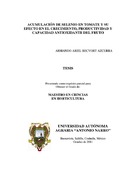Mostrar el registro sencillo del ítem
Acumulación de selenio en tomate y su efecto en el crecimiento, productividad y capacidad antioxidante del fruto
| dc.contributor.advisor | Benavides Mendoza, Adalberto | |
| dc.contributor.author | Becvort Azcurra, Armando Ariel | |
| dc.contributor.other | Ramírez Rodríguez, Homero | |
| dc.contributor.other | Robledo Torres, Valentín | |
| dc.contributor.other | Vázquez Badillo, Marío Ernesto | |
| dc.date.issued | 2011-10 | |
| dc.identifier.uri | http://repositorio.uaaan.mx:8080/xmlui/handle/123456789/3997 | |
| dc.description | La aplicación de selenito de sodio por medio del riego y por aspersión foliar dio lugar a la acumulación de selenio en la raíz, tallos y hojas y fruto de tomate. El crecimiento de la planta y la producción de fruto fueron afectados negativamente por la concentración alta de selenio en los tejidos vegetales. En cambio la baja concentración de selenio permitió mantener o aumentar la biomasa y la producción de fruto. | |
| dc.description.abstract | "El objetivo del estudio fue determinar el efecto de la aplicación de selenito desodio, en el riego y por aspersión foliar, sobre la acumulación de selenio en el fruto, tallos y hojas de tomate en invernadero. Se verificó el efecto sobre el crecimiento de la planta, el rendimiento y la capacidad antioxidante total (TAS) de los frutos. El experimento fue dividido en tres etapas: (1) aplicación de selenio en 0, 10 y 20 mg/L en la solución fertilizante en tres sustratos: suelo, peat moss y perlita; (2) aplicación de selenio en 0, 2.5 y 5 mg/L en el riego en suelo y perlita; (3) aplicación de selenio en 0, 10 y 20 mg/L en aspersión foliar cada 20 días. El selenio en 10 y 20 mg/L en la solución nutritiva causó un efecto negativo en la biomasa, con acumulación de selenio en raíz, tallo y hojas >15 µg/g. En cambio el rendimiento de fruto fue mayor con 10 mg/L pero disminuyó fuertemente con 20 mg/L. Al aplicar selenio en el riego a 2.5 y 5 mg/L no se modificó el rendimiento ni la biomasa, con acumulación de selenio en el fruto >10 µg/g. La aplicación foliar de selenio permitió una acumulación de selenio en el fruto >10 µg/g conjuntamente con aumento en la biomasa pero sin aumentar la producción de fruto. La acumulación de selenio en frutos de plantas testigo llegó a 6 µg/g, con un máximo de 20.89 µg/g al aplicar 5 mg/L de selenio en el riego. La TAS del fruto disminuyó 25% en los tratamientos con 10 y 20 mg/L aplicados por el riego. En el resto de los tratamientos el efecto del selenio fue positivo elevándose la TAS en 36% al aplicar 20 mg/L de selenio por aspersión foliar y 38% con 5 mg/L en el riego" | |
| dc.format | ||
| dc.language | Español | |
| dc.publisher | Universidad Autónoma Agraria Antonio Narro | |
| dc.rights | Acceso Abierto | |
| dc.rights.uri | CC BY-NC-ND - Atribución-NoComercial-SinDerivadas | |
| dc.subject | CIENCIAS AGROPECUARIAS Y BIOTECNOLOGÍA | |
| dc.subject.other | Tomate | |
| dc.subject.other | Cultivo | |
| dc.subject.other | Consumo | |
| dc.title | Acumulación de selenio en tomate y su efecto en el crecimiento, productividad y capacidad antioxidante del fruto | |
| dc.type | Tesis de maestría | es_MX |
| dc.description.abstractEn | The aim of this study was to determine the effect of sodium selenite application through irrigation water and foliar spray on the selenium accumulation in the fruit, stems and leaves of greenhouse tomato. It was verified the effect on plant growth, yield and total antioxidant status (TAS) of the fruits. The experiment was divided into three stages: (1) application of selenium at 0, 10 and 20 mg/L in the fertilizer solution using three substrates: soil, peat moss and perlite; (2) application of selenium at 0, 2.5 and viii 5 mg/L in the fertilizer in soil and perlite substrates; (3) application of selenium at 0, 10 and 20 mg/L as a foliar spray every 20 days. Selenium at 10 and 20 mg/L in the fertilizer solution caused a negative effect on biomass, accumulating selenium in root and shoot tissue >15 µg/g. The fruit yield was higher with 10 mg/L but decreased drastically with 20 mg/L. Applying the fertilizer solution with 2.5 and 5 mg/L of selenium did not change fruit yield or biomass, accumulating selenium in fruit >10 µg/g. Foliar application of selenium allowed an accumulation of selenium in fruit >10 µg/g together with an increase in shoot biomass without increasing fruit production. The concentration of selenium in fruits from control plants was 6 µg/g, reaching 20.89 µg/g by applying 5 mg/L of selenium in the fertilizer solution. TAS of fruit decreased 25% in the treatment of selenium with 10 and 20 mg/L applied by fertilizer solution. The rest of the selenium treatments increased TAS; specifically, in 36% when applied 20 mg/L of selenium foliar spray and 38% with 5 mg/L in fertilizer solution. | |
| dc.type.version | Versión publicada | |
| dc.audience | Estudiantes | |
| dc.audience | Investigadores | |
| dc.publisher.place | Saltillo, Coahuila, México | |
| dc.type.thesis | Digital |
